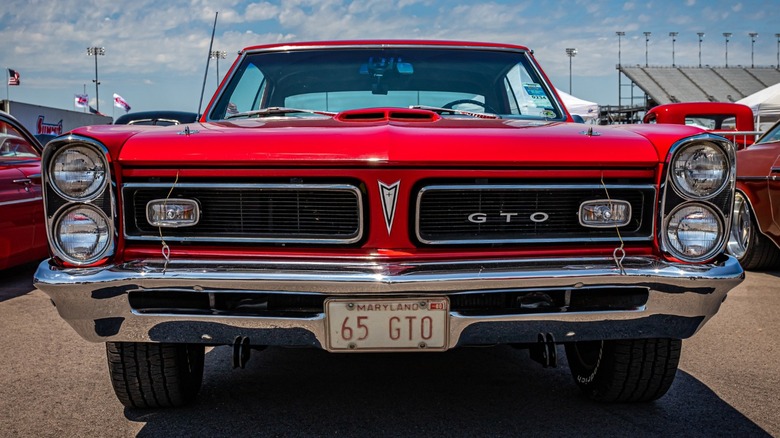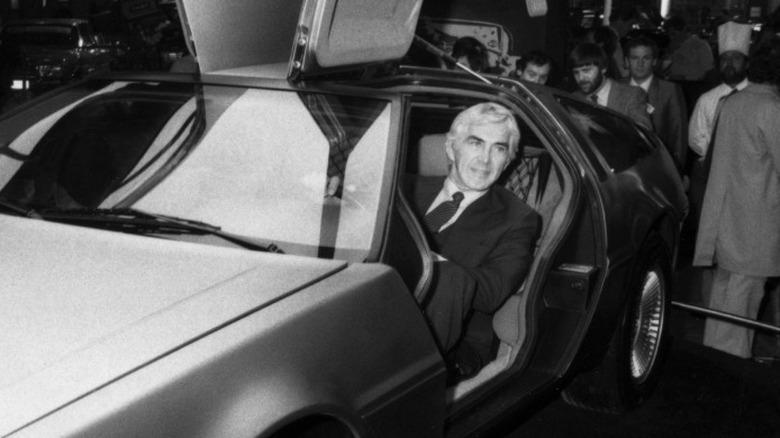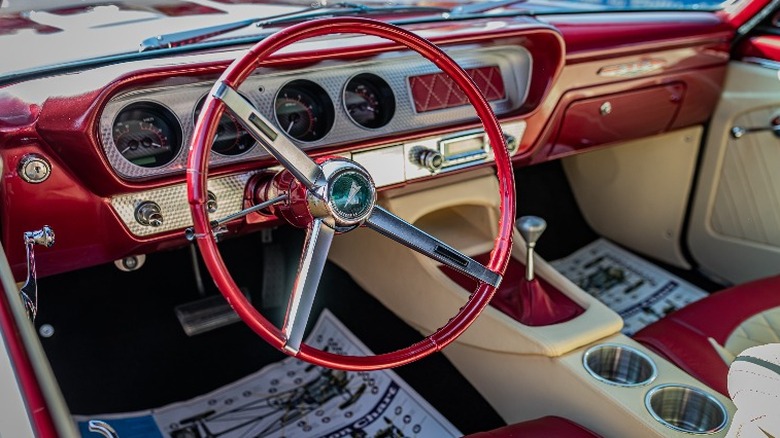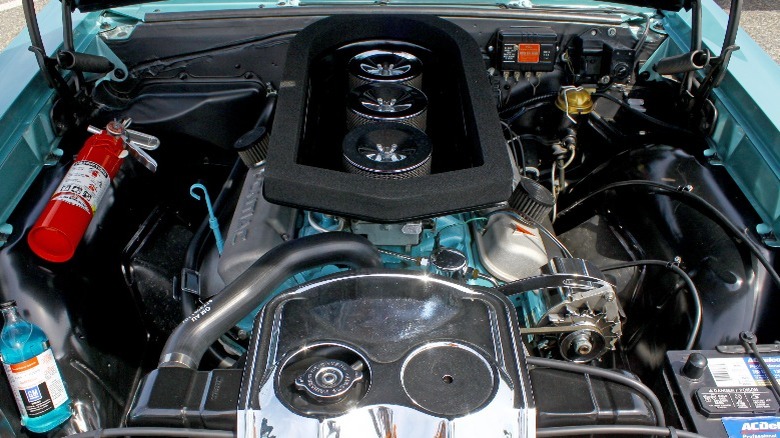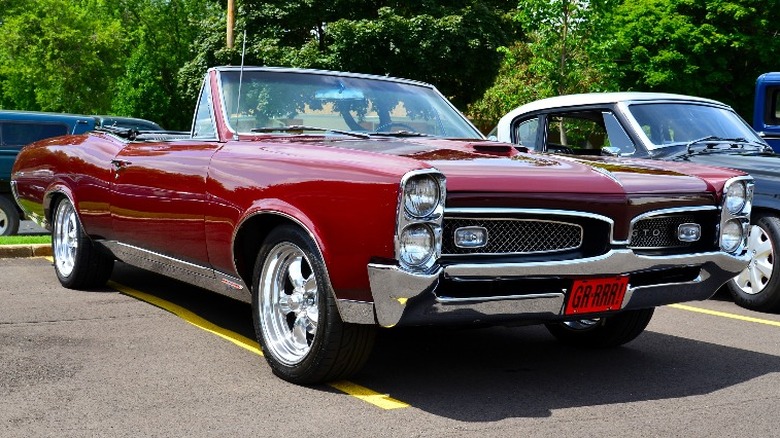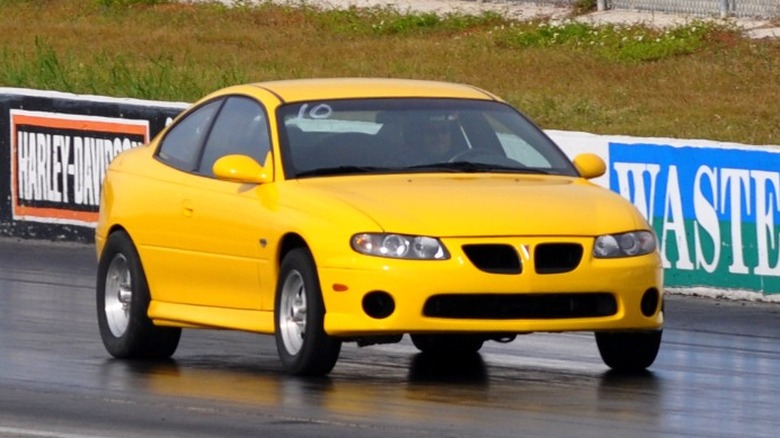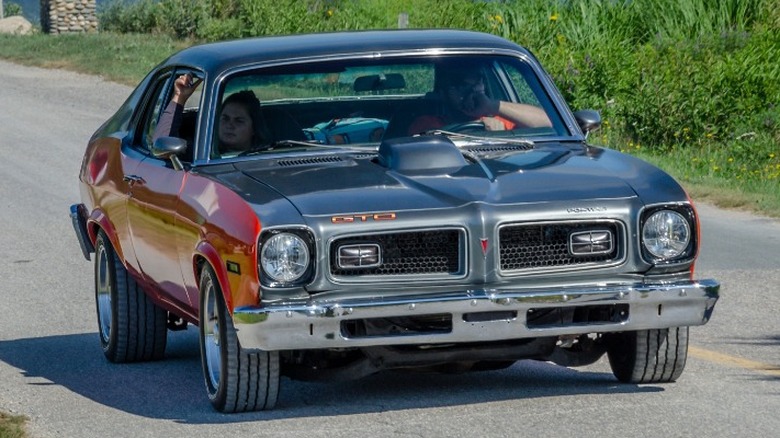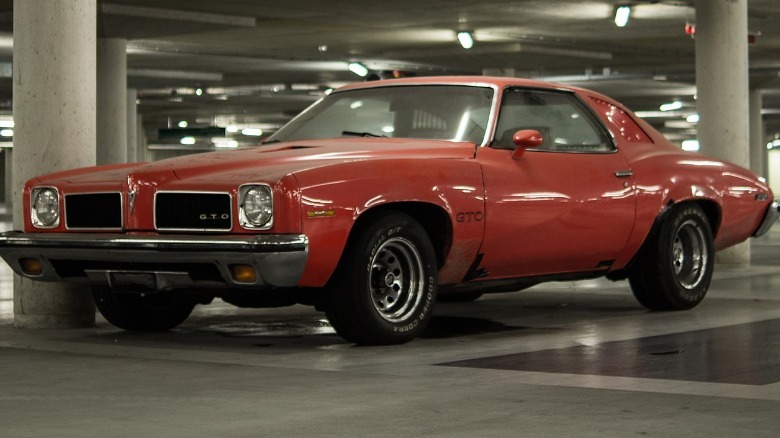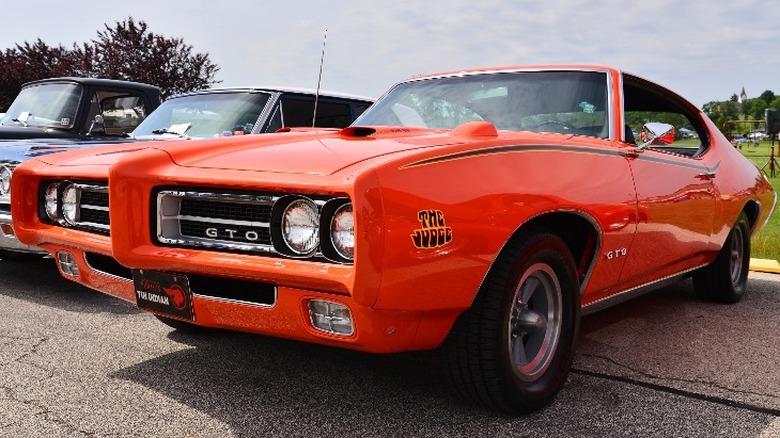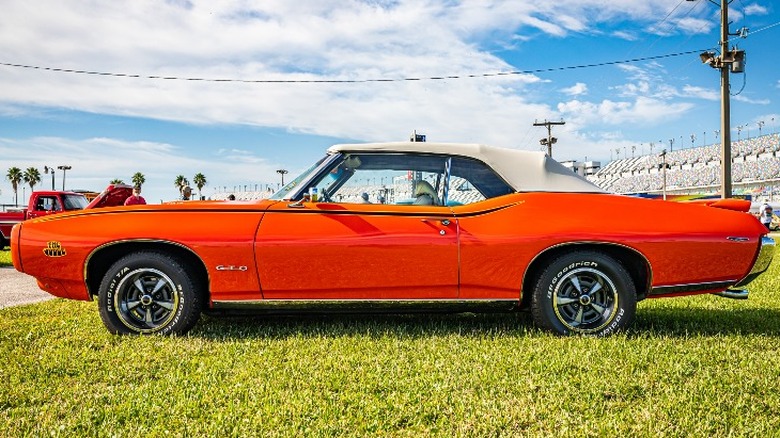The Coolest Facts You Should Know About The Pontiac GTO
Widely hailed as the first real muscle car, the Pontiac GTO unleashed a horsepower war that continued until the development of the EPA and strict emissions compliance, causing the demise of horsepower for a generation. The GTO ended up being wildly successful and helped to cement Pontiac as the company that would later proclaim, "We Build Excitement!"
The first GTO model showed up as an option to the 1964 Tempest LeMans, stuffed with Pontiac's 389 cubic inch V8 under the hood. As it was initially an option package, the GTO could be ordered as a two-door coupe, hardtop coupe, or convertible, according to the Volo Auto Museum. It would go on to be a stand-alone model in 1966 and survive three more generations through the 1974 model year but resurrected 30 years later for its fifth and final generation. The Pontiac GTO has had an outsized influence on muscle car culture and it remains a favorite among classic car collectors. While it is far less common to see a GTO on the streets than it once was, this Pontiac still holds a special place in automotive history. Diving into the model's history uncovers some of the coolest facts you should know about the legendary Pontiac GTO.
The GTO was created by a legend
The option package for a high-powered Tempest LeMans was the brainchild of Pontiac boss John DeLorean, a legend in his own right. At 40, DeLorean was the youngest executive to ever run a division of General Motors at the time, and he was eager to prove himself with well-made products that appealed to younger buyers and would energize the brand (via Pontiac Preservation Association).
Early in his tenure, he worked with Pontiac engineers and executives on some fresh ideas for the brand, and they came upon a concept of installing a 389 into one of the prototypes for the upcoming LeMans. Since the engine would fit without any major modifications, the concept immediately left the drawing board, per Horsepower Memories. THis would be DeLorean's first major achievement in a career that would later include the Trans Am, Chevrolet Vega, and the automotive failure that would go on to achieve the status of legend and icon simultaneously, the DeLorean DMC-12.
Corporate misjudged its potential
By 1960, GM was the largest company in America, according to CNN Money. As a corporate behemoth, top brass tended to be conservative in business affairs by nature. Furthermore, providing products that would turn profits was ultimately more important than delivering innovative products for the sake of innovation. Therefore, new ideas were subject to scrutiny by the powers that be to the extent that nothing would leave the factories if they weren't ready for a public with cash in hand.
Because of the corporate leadership's reticence to push forward with new ideas, the GTO was met with pushback from management. The biggest obstacle was Pontiac's sales manager, Frank Bridge, who was not enamored with the idea of building up Pontiac into a performance-oriented division. However, with some cajoling by chief engineer Pete Estes, a run of 5,000 units was authorized, although Bridge had said they would never sell. In the end, Bridge would have an egg on his face as Pontiac had managed to sell 32,450 copies of the GTO by the end of the model year (via Ate Up With Motor).
The GTO broke company policy
In 1957, the American Automobile Association, a lobbying group for automakers, came to an official agreement in a resolution for all members to end their active participation in motorsports. This came as a result of a few things including a high-profile accident in 1955 that killed 80 spectators and the driver. Also, the federal government's interest in investigating potential antitrust violations caused executives to want to make sure their organizations were squeaky clean. Third was pushback from independent teams who wanted car manufacturers out of racing entirely. They argued that manufacturers could unfairly compete by having essentially unlimited budgets to develop their cars (via Pontiac V8).
GM remained a part of the resolution in the early sixties, and a high-powered car ready for the track was not in the cards for any GM division, including Pontiac. To skirt the official position within GM and introduce the GTO, DeLorean had to work around the edges and introduce the car without raising any eyebrows. While the GM ban meant that Pontiac could not bring a model to market with an engine larger than 330 cubic inches, according to Horsepower Memories, DeLorean made it an option that customers could choose when ordering a new Tempest LeMans, and that is how the GTO came to be. By 1966, the popularity and profitability of the car were so undeniable that GM could not turn its back on the car and it became its own model.
GTO advertising pushed boundaries
Part of the ban on racing meant that divisions could not produce cars with obvious features for racing and high-performance engines, but this also extended to advertising. The AMA resolution had members commit to using engine features to advertise the cars' highway cruising abilities and other benefits to average drivers, rather than how they help win on the track. This meant the new GTO performance special could not be listed as such in the popular magazines and newspapers of the day.
With DeLorean already known for pushing boundaries and being the guy in charge of Pontiac, he found a way to push the envelope of ads for the GTO as well. For the 1968 model year, Hagerty tells us that Pontiac advertising agency McManus, John, & Adams placed a new GTO in a turnaround lane at a northern section of Woodward avenue, a well-known location for illegal street racing. The car was set such that it was obvious where it was with the implication that it was awaiting a challenger for a good old-fashioned street race. The only text included read, "The Great One by Pontiac, You know the rest of the story." The ad was provocative and it elicited a quick response from corporate. The hammer came down on Pontiac and this two-page spread ran only once.
Sammy Davis, Jr. inspired its most special edition
In the late '60s, there was no other comedy show quite like Rowan and Martin's Laugh-In. It was a one-hour primetime comedy show consisting of sketch comedy that tended to push up against the boundaries of decency of the time. Parts of what made the show popular were the over-the-top comedy as well as the list of special guests, who were popular entertainers of the were, according to TV Tropes. Stars such as Lily Tomlin and Goldie Hawn had careers blasted off from starring on the show, and special guests included the likes of Leonard Nimoy, The Bee Gees, Bob Newhart, and Liberace. It was truly a star-studded roster.
Among the special guests was Rat Pack member and all-around entertainer Sammy Davis, Jr., who starred in one of the show's most popular and loved recurring sketches. In this memorable scene, Sammy Davis, Jr. is dressed as a judge, wig and all, to adjudicate some rather matters with all the pomp and circumstance of a three-ring circus. While the skit only aired a few times, it left a mark on popular culture and particularly on John DeLorean who, according to Silodrome, vetoed the original E/T designation in favor of The Judge. While everyone gets ready for a laugh when Sammy Davis, Jr. says it, those at the race track better beware when "Here comes the Judge."
The GTO sparred with Ferrari
The rivalry between Henry Ford and Enzo Ferrari is legendary, spawning a full-length movie with all the details. However, John Delorean specifically chose to call his new high-performance model GTO with inspiration from the Ferrari 250 GTO, the world's most valuable classic car, selling for nearly $50 million in 2018.
In 1964, not everyone thought the car was deserving of the GTO designation and took up the cause to show the reasons why. Car and Driver took it upon themselves to perform a head-to-head matchup of the two cars to prove once and for all that Ferrari deserves to be the reigning champion. While the magazine staff was genuinely impressed with the car, it was still no Prancing Horse. Therefore they committed to doing what they said was the most exhaustive test performed to that point and compared the cars in real-world tests for several thousand miles.
In quite a sensational test, the Tempest outperformed the Ferrari and impressed the reviewers. It made the cover in 1964, however, it was only an illustration of the two cars together. In reality, according to the YouTube channel Old Car Memories, it was all a facade, and the Tempest had been modified. After the test was run, the engine had a spun bearing and could not be driven without a full teardown and rebuild. It made for sensational reading and the magazine derived a lot of publicity for it, but it had all been staged.
The GTO was resurrected from Down Under
Before Pontiac's eventual demise amidst the economic downturn of 2009, the GTO moniker was revived. Reusing older nameplates is a common practice, but with varying degrees of success. This rings especially true since the end of unregulated emissions led to cars with names that were hollow shells compared to their horsepower-laden predecessors. However, the GTO did not suffer this fate with its reprisal.
Pontiac brought back the GTO for the 2004 model year. To bring a new model with real horsepower to market is very expensive, so management opted for an existing model that could be reworked into the GTO. GM found this model from its lineup of cars under the Holden badge in Australia. The Holden Monaro was a fire-breathing coupe with rear-wheel-drive and a bona fide 5.7-liter LS V8 under the hood, according to Hagerty.
This new GTO was a true muscle car. It had two doors, four seats, a V8 engine, and rear-wheel drive. It may have been Australian, but it had all the right components. The engine produced 350 horsepower and was sent to the wheels via a 6-speed manual or four-speed automatic transmission. However, while it held all the right pieces to be a successor to the original, sales fell short. The car performed well, but the styling was criticized as bland and uninspired. The buying public must have felt it lacked the most important part of a genuine muscle car, good looks.
Two generations remain unloved
The GTO is a beloved muscle car from the dawn of the era and it lasted through a total of five generations. The second generation ran through 1972 and a new model arrived the next year. By the end of the 1972 model year, car companies were scrambling to adopt new emissions regulations and the muscle car era was quickly coming to a close. These problems were exasperated by an oil crisis raising the price of gas and caused nationwide shortages. Big gas guzzlers had lost their luster, and a revamped muscle car without the muscle was doomed to fail.
[Image by www.Pixel.la Free Stock Photos via Wikimedia Commons | Cropped and scaled | CC0]
The 1973 GTO was the first with options that upgraded its styling more than performance. Pontiac used the revamped LeMans, added some accents and emblems, and installed some less-than-clever NACA ducts on the hood, which, as Hagerty explains, were fake. Also, sales for this year only totaled 4,806. Pontiac tried again the next year with a new downsized model based on the X-body Pontiac Ventura, but with similar results. This time the only engine was a 350 cubic inch V8 with a four-barrel carburetor, although power output was a lowly 200 horsepower, per Motor Trend. Again the GTO package was more about looks than anything, and even its functional shaker hood scoop could not save it as only 7,000 units left the factory in 1974.
Orange was the new red
The Judge option was introduced for the 1969 model year and only lasted through 1970. However short-lived it was, its popularity has never waned, leaving us with one of the most recognizable muscle cars to ever come from Detroit.
The Audrain Museum tells us that GTO sales were on the decline and Pontiac came up with this package to bolster sales. The Judge could be ordered with a choice of 366 or 370-horsepower Ram Air engines in either hardtop or convertible body styles. Only 108 of the latter were produced, making them rare and valuable today. The Judge came well-equipped mechanically and featured special "The Judge" decals, a rear spoiler, and factory pinstripes. While this car came with an impressive list of features, it was originally only offered in one color, and it was not orange. Despite what your eyes may tell you, the 1969 Pontiac GTO The Judge was painted with Carousel Red paint.
A Judge commands respect
Judges who serve in the judicial system, whether it is municipal, state, or federal, are members of society who have earned a great deal of respect by their peers and the public. They are meant to be unbiased arbiters who make decisions based on facts and the law as written, although this does not always hold true. Regardless of any indiscretions or anomalous decisions crafted by these individuals, their positions of power come with substantial salaries commensurate with the level of court in which they work.
Likewise, a GTO Judge also commands respect, but not necessarily due to any balanced opinions and discernment of facts. The Judge models are valued for their scarcity, just as judges in courts are scarce due to the high requirements set as conditions of employment. A limited number of GTO The Judge cars were sold when new and have risen in value ever since. Classic.com lists the average selling price at $72,256, which is a respectable figure for a well-heeled muscle car. The most scarce of these cars, much like a Supreme Court justice, can easily exceed the salary of Chief Justice John Roberts, whose annual pay is currently set at $280,500, according to Time. While convertible Judge GTOs outnumber Supreme Court Justice by 99, auction prices can nearly double that of the Chief Justice salary by climbing up to $440,000, which occurred at Barrett-Jackson in 2021.
